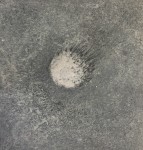The artworks were created as an answer to 2017 years edition of the Przemiany Festival (Copernicus Science Centre, Warsaw) – human exploration of the outer space (title of the exhibition: “Going back to the Moon”). My main focus during the creation process was a quote of Richard Feynman, an outstanding physicist: “It does not do harm to the mystery to know a little about it. For far more marvelous is the truth than any artists of the past imagined! Why do the poets of the present not speak of it? What men are poets who can speak of Jupiter if he were a man, but if he is an immense spinning sphere of methane and ammonia must be silent?”.
The object that I chose in the context of human conquest of the outer space is Jupiter. The biggest planet of the Solar System, so called gas giant, is a very significant object when it comes to space missions. Each of the works I created refers to a selected aspect of Jupiter’s connection with conquest of the outer space.
- “Gravity”, “Impressions of Jupiter series”, 7/7cm, oil pastels on paper, 2017
- “Gravity”, “Impressions of Jupiter series”, 7/7cm, oil pastels on paper, 2017
- “Gravity”, “Impressions of Jupiter series”, 7/7cm, oil pastels on paper, 2017
One of the triptychs is about gravity (“Grawitacja / Gravity”) and how Jupiter helps missions focused on research of the periphery of the Solar System as well as those directed beyond its borders. As the most massive object (except for the Sun) in our cosmic neighborhood, Jupiter allows to perform a gravity assist maneuver. This way the space vehicle can accelerate and reach the designated area in a much shorter time. A gravity assist maneuver allows to increase the efficiency of space vehicle engines by more than three times. For example Voyager 1 and Voyager 2 used Jupiter’s gravitational assist.
- “Life”, “Impressions of Jupiter” series, 7/7 cm, oil pastels on paper, 2017
- “Life”, “Impressions of Jupiter” series, 7/7 cm, white ink on paper, 2017
- “Life”, “Impressions of Jupiter” series, 7/7 cm, oil pastels on paper, 2017
The second triptych (“Life / Life”) is associated with one of Jupiter’s moons (Europa) and possible life outside of our planet, which we may find in its 90 km deep ocean hidden under thick ice layer. Even if we find life in the oceans of Europa, it will most likely be microbiological and primitive from our point of view. Nevertheless, it will be a discovery of great importance. So far, life is a phenomenon observed only on our planet.
- “Interaction”, “Impressions of Jupiter” series, 7/7 cm, charcoal on paper, 2017
- “Interaction”, “Impressions of Jupiter” series, 7/7 cm, charcoal on paper, 2017
- “Interaction”, “Impressions of Jupiter” series, 7/7 cm, charcoal on paper, 2017
The third triptych (“Interakcja / Interaction”) is related to the research of Jupiter itself, and what consequences this knowledge can have for a human in the context of exploring the Solar System, its evolution, and the formation and evolution of other extrasolar systems. Without such knowledge, space exploration is not possible, and as the ever-present data from the Juno mission continues to show, Jupiter still has many issues that require astrophysicists to revalue a number of theoretical models and to find the causes of phenomena taking place on many levels of gas clouds.








